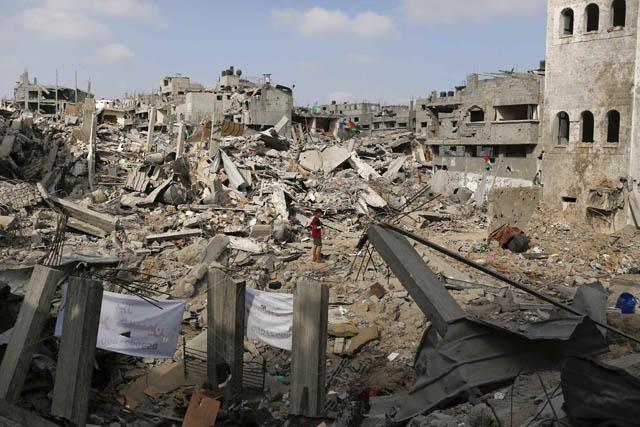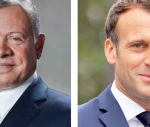You are here
Young Jordanian scientists showcase innovative solutions
By Suzanna Goussous - May 09,2017 - Last updated at May 09,2017

Participants from Jordan who qualified for the Intel International Science and Engineering Fair pose for a group photo with Education Minister Omar Razzaz in Amman on Monday (Photo courtesy of the Abdul Hameed Shoman Foundation)
AMMAN — Eighteen young participants from Jordan showcased their science projects on Sunday, which qualified them for the Intel International Science and Engineering Fair (Intel ISEF).
The exhibition, held under the patronage of Education Minister Omar Razzaz, saw the participation of 12 projects, which will compete in the final stage of the competition, that will be held in Los Angeles, according to organisers.
Among the projects are: An electricity generator created by Omar Nassar, a magnetic brush by Omar Ahmad and Zaid Atiyat, a tree rescue project by Sanad Kiswani and Bashir Dabbagh, a lead-free environment project by Bayan Abu Ragheb and Aya Shihadeh, a project to sanitise factory waste water by Tala Mismar and Hala Majali, a laser shield project by Dana Arabiyyat, a study on the effects of mint oil on whitefly by Farah Shloul and Lana Mughrabi, and the Smart Elderly Helper project by Raad Kloub.
The education minister said the creativity and innovation of the students, between the ages of 12 and 18, prove that they can think “outside the box” and create their own products in different fields.
“There is a huge difference between the students who learn through textbooks and those who practise what they learn,” he said at the exhibition, which was held at the Abdul Hameed Shoman Foundation.
Razzaz emphasised the importance of interactive education, which promotes innovation and the personal growth of students.
Chief Executive Officer of the Abdul Hameed Shoman Foundation, Valentina Qussisiya, said the foundation provided financial support for the Jordanian delegation’s travel during the exhibition period. It also provided design, development and printing of exhibits, in addition to training in presentation skills.
Tenth grader Yousef Nawafleh, worked on the thermoelectric dry energy project, which uses dry ice.
He said the thermal dry energy is an energy type that is clean and permanent, while the dry ice, he added, is the solid form of carbon dioxide at a -78.5°C.
The project aims to shed light on how to benefit from the reduced temperature of dry ice, the student said, adding that the project “enables us to produce a constant electric current without the need for external sources that are polluting the environment”.
Ban Ghreir, from UNRWA’s Wakaleh School, started a project to recycle a solid-waste material produced by cement factories, cement-kiln dust, which 60 per cent of the world’s factories consign to landfills, she said.
Another option is to keep it in the factory, taking up space. Ghreir explained that 40 per cent of factories recycle the material with the cement and use it again.
Her idea, she said, is to recycle the cement-kiln dust, instead of disposing it in landfills or storing it in factories.
“Recycling the cement-kiln dust, to improve the mechanical properties of highways, this project aims to prevent cracks in asphalt layers, with its feasibility amounting to almost JD zero,” the 14-year-old said.
For their part, Tamer Haddadin and Rakan Nasriddin created a solar system to absorb thermal energy, discovering that the materials which were most absorbent were Paraffin oil and graphite, which they used to create the piping system.
Sixteen-year-old Tala Haddad, from the Jubilee High School, created the “Express Without Stress” project, which aims to help people with speech problems to pronounce sounds and words more freely.
“More than 15 million people around the world suffer from stuttering. This has negative social effects; they start fearing talking and can be bullied,” she said, adding that the project took around four months of work.
The device she created works on heartbeats. When the heart rate is between 60-100 per minute, which is the normal range, the training course starts, Haddad said.
Users can enter words on keyboards and listen to them as audio, with the pulse sensor working to check the heartbeat rate.
If the heartbeat increases due to stress, the training course will stop and vibration sensors will start working on face and jaw muscles, to warn the patient, she said.
She aims to develop the device into a mobile application to monitor the improvement of the user and a community network for users to communicate and track the progress of one another.
Related Articles
AMMAN — Environment Ministry personnel, in cooperation with the Rangers and the Jordan Food and Drug Administration, have uncovered four unl
With thousands of homes reduced to rubble and its infrastructure in ruins, Gaza's reconstruction will cost billions and require at least an easing of Israel's blockade to allow in building materials.
Suspicions that shooting stars come from comet dust, transformed into fiery streaks as they hit Earth’s atmosphere, have been bolstered by Europe’s Rosetta space mission, scientists reported Monday.


















